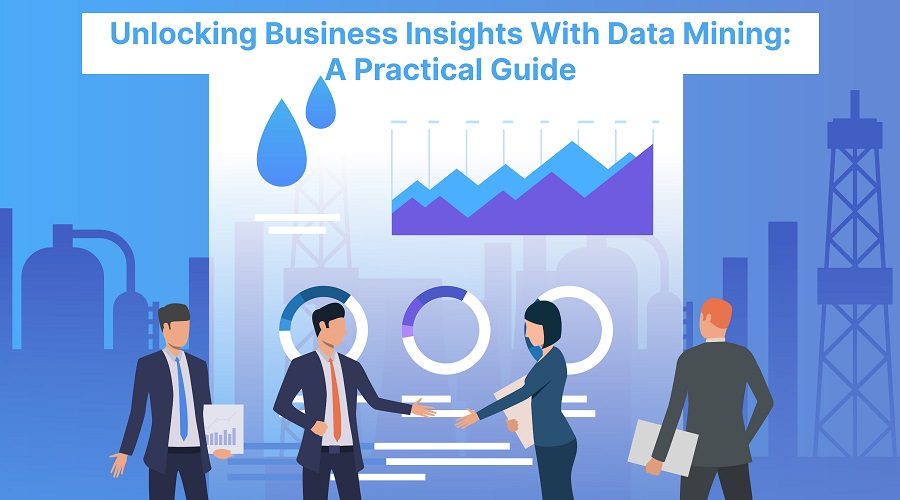Imagine uncovering patterns in your data that reveal why customers leave, which products succeed, or when demand will spike. Data Mining makes this possible. By extracting valuable insights from vast datasets, businesses can improve decisions, detect fraud, and personalize customer experiences. In this post, you’ll learn how data mining works, where it’s most impactful, and how to harness it without getting lost in technical jargon.Imagine uncovering patterns in your data that reveal why customers leave, which products succeed, or when demand will spike. Data Mining makes this possible. By extracting valuable insights from vast datasets, businesses can improve decisions, detect fraud, and personalize customer experiences. In this post, you’ll learn how data mining works, where it’s most impactful, and how to harness it without getting lost in technical jargon.
What Is Data Mining?
Data mining is the process of analyzing large volumes of information to discover meaningful patterns, trends, and relationships. It’s like digging for gold in a mountain of data using algorithms and statistics to turn raw inputs into actionable insights.
Key Benefits of Data Mining
- Enhanced decision-making based on real trends, not gut feelings
- Fraud detection by spotting anomalies in transactions
- Customer segmentation for personalised marketing campaigns
- Predictive analytics to anticipate future outcomes
How Data Mining Works: The Core Processes
1. Data Collection & Preparation
Gather data from various sources databases, logs, sensors, or social media. Cleanse it to remove duplicates, outliers, and inconsistencies. A polished dataset is the foundation of reliable insights.
2. Data Exploration
Use descriptive statistics and data visualization to understand the dataset’s structure and spot initial patterns or anomalies. Tools like histograms, scatterplots, and box plots play a big role here.
3. Model Selection & Training
Choose the right algorithm classification, clustering, regression, or association rule mining. Train it on a portion of your data and validate using another part. This phases shapes how well the model reflects reality.
4. Evaluation & Interpretation
Assess metrics like accuracy, precision, or recall to ensure the model performs accurately. Then interpret its output what are the key drivers of your insights?
5. Deployment & Monitoring
Integrate your model into dashboards, workflows, or decision-making systems. Continuously track performance and retrain it as your data evolves.
Where Data Mining Makes an Impact
Finance & Risk Management
Detect fraud and anticipate credit default risks. Real-time pattern recognition reduces losses and improves trust.
Retail & E-commerce
Predict customer behaviour what they’ll buy, when, and how much. Optimize pricing strategies and inventory management for higher profits.
Healthcare & Pharmaceuticals
Identify disease risk factors or drug efficacy trends. Data mining accelerates medical research and improves patient outcomes.
Manufacturing & Supply Chain
Spot production inefficiencies, forecast demand, and reduce waste. This leads to leaner operations and increased productivity.
Best Practices for Successful Data Mining
Start with Right Questions
Clarify your goals: “Which customers are likely to churn?” “Where are the fraud hotspots?” A well-defined problem leads to focused solutions.
Balance Model Accuracy and Complexity
More complex models aren’t always better. Prefer interpretable models when explainability matters, and reserve “black box” approaches (like deep learning) when precision trumps transparency.
Embrace Cross-functional Collaboration
Bring together data scientists, domain experts, and decision-makers. Their combined lenses ensure insights are actionable and aligned with business goals.
Audit Data Quality Regularly
Poor data quality undermines data mining. Automate checks, track missingness, and establish a clear data governance policy.
Common Pitfalls and How to Avoid Them
Overfitting
A model that’s too tailored to historical data may perform poorly on new cases. Counter this with techniques like cross-validation and regularization.
Ignoring Data Drift
Data patterns often shift. Regularly monitor and retrain models to reflect current realities.
Misinterpreting Correlation as Causation
Just because two variables move together doesn’t mean one causes the other. Use techniques like A/B testing or causal inference to confirm directionality.
How to Get Started with Data Mining
- Choose your tools: Start with open-source options like Python (scikit-learn, Pandas) or R, and scale to platforms like RapidMiner or AWS if needed.
- Learn the basics: Understand statistics, algorithm fundamentals, and data visualization techniques.
- Begin with a pilot project: Tackle a clear, measurable problem like reducing churn or predicting sales.
- Build a feedback loop: Gather feedback from stakeholders, refine your model, and integrate insights into decision-making.
FAQs about Data Mining
1. What’s the difference between data mining and data analysis?
Data analysis often focuses on describing past trends. Data mining goes deeper, using algorithms to identify hidden patterns and predict future outcomes.
2. Is data mining only for large enterprises?
Absolutely not. Even small businesses can benefit by using customer sales data to personalize offers or predict inventory needs.
3. Do I need programming skills to do data mining?
While coding helps, there are no-code tools like RapidMiner or Orange. However, scripting in Python or R gives you more flexibility and power.
4. How do I protect sensitive data during mining?
Use anonymization, encryption, and governance frameworks to ensure privacy and compliance, especially with personal or medical data.
5. How long does it take to see ROI from data mining?
It varies. Some organizations see improvements within weeks, while others need months to deploy robust models. Pilot studies often yield the quickest wins.





Comments